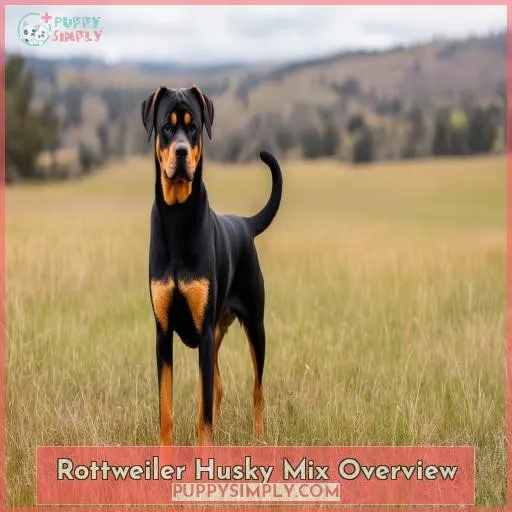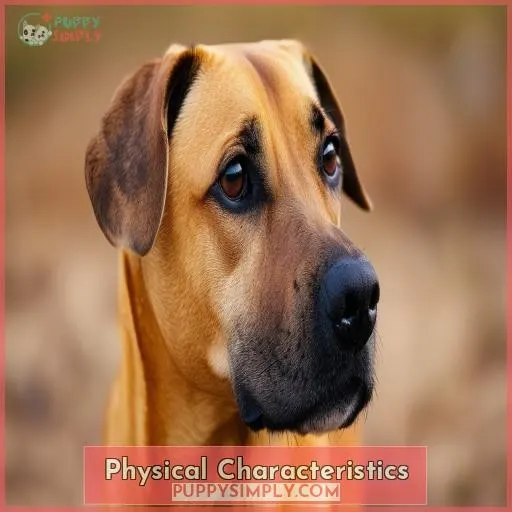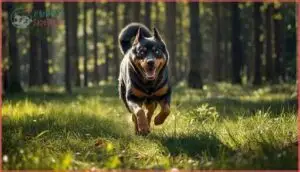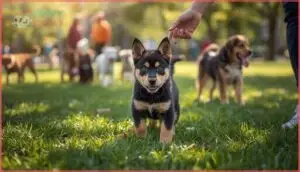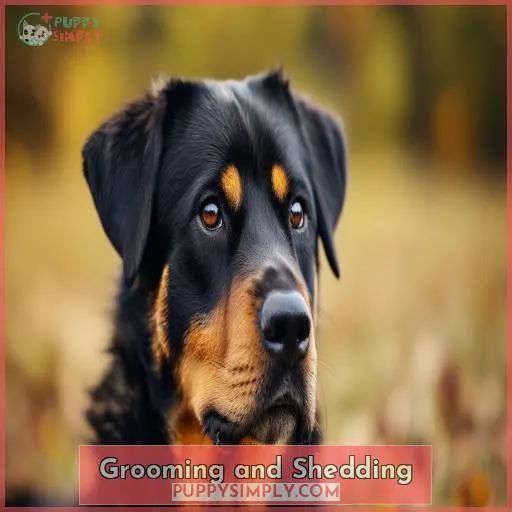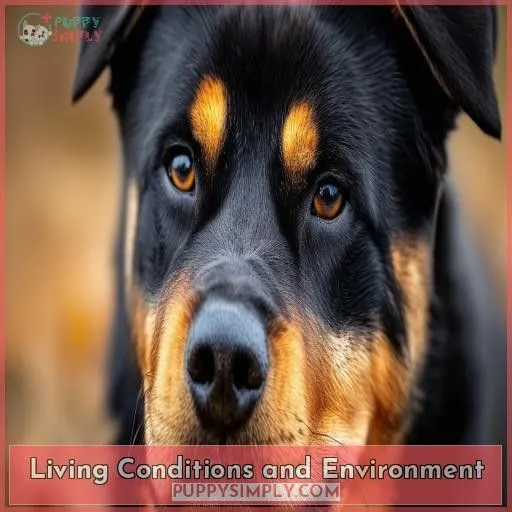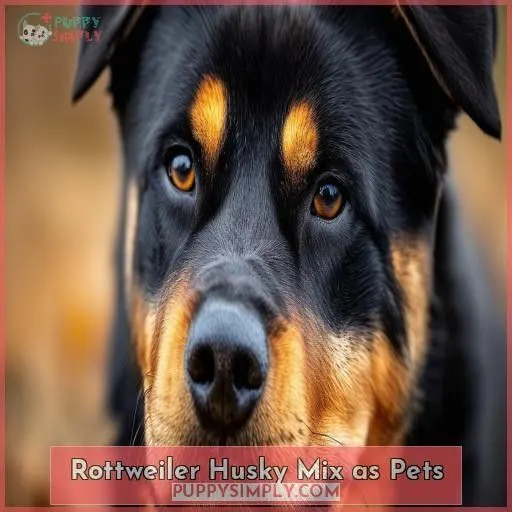This site is supported by our readers. We may earn a commission, at no cost to you, if you purchase through links.

You’ll get a loyal, energetic companion that thrives on outdoor activities like hiking and sledding. Be prepared for an athletic dog that needs at least 90 minutes of vigorous exercise daily, along with mental stimulation.
Early training and socialization are essential for this intelligent, yet sometimes stubborn breed. With patience and positive reinforcement, the Rottsky can be a loving addition to an active family.
Ready to uncover the unique traits that make this hybrid so special?
Table Of Contents
- Key Takeaways
- Rottweiler Husky Mix Overview
- Physical Characteristics
- Temperament and Personality
- Exercise and Activity Needs
- Training and Socialization
- Grooming and Shedding
- Health and Lifespan
- Living Conditions and Environment
- Feeding and Nutrition
- Rottweiler Husky Mix as Pets
- Frequently Asked Questions (FAQs)
- Is Husky Rottweiler a good mix?
- How big do Rottskys get?
- Do Rottweiler Husky mix have health issues?
- What is the rarest Husky mix?
- What is the origin of this mixed breed?
- Are Rottweiler Husky mixes good with children?
- How much do Rottweiler Husky mix puppies cost?
- What are some common behavioral issues with this breed?
- Are Rottweiler Husky mixes easy to train for novice owners?
- Conclusion
Key Takeaways
- Buckle up for an adventure with this lively hybrid! The Rottsky’s boundless energy and athleticism demand an active lifestyle filled with outdoor pursuits like hiking, running, and even pulling sleds. Couch potatoes need not apply.
- Though fiercely loyal and protective of their pack, early socialization and consistent training are a must to channel the Rottsky’s stubborn streak and ensure this pup plays well with others. Patience and positive reinforcement are your secret weapons.
- With their thick double coat and moderate grooming needs, be prepared for some serious shedding sessions, especially during seasonal blows. Investing in a quality vacuum and brushing tools is wise unless you enjoy a furry home decor.
- While their unique blend of Rottweiler guardianship and Husky endurance makes for an enviable companion, potential health issues like hip dysplasia and bloat mean responsible ownership is key. Keeping up with vet visits and genetic testing ensures your adventure buddy stays happy and healthy for the long haul.
Rottweiler Husky Mix Overview
You’re intrigued by the Rottweiler Husky mix, also known as the Rottsky – an adaptable breed with an adventurous spirit.
This hybrid combines the protective nature of the Rottweiler and the endurance of the Husky, resulting in a loyal companion that thrives on enrichment.
With proper training and socialization from an early age, the Rottsky can make an excellent family pet.
However, ensuring their healthcare needs are met through pet insurance and genetic testing is essential.
Their high energy levels demand a commitment to regular exercise and mental stimulation.
Embrace the unique blend of intelligence and affection this hybrid offers for an enriching experience.
Physical Characteristics
The Rottweiler Husky mix, also known as the Rottsky, is a large and muscular dog, typically weighing between 55 and 95 pounds and standing 20 to 26 inches tall. Their coat can range from medium to long length, with colors including black, brown, cream, white, sable, and gray, reflecting their diverse heritage.
Size and Weight
As a Rottweiler Husky mix, you’re looking at a large-sized dog ranging from 20-26 inches tall and 55-95 pounds. However, size variations exist due to genetic factors. Monitoring growth patterns and weight fluctuations is essential for ensuring your Rottsky stays within healthy breed standards and avoiding potential health implications.
Coat and Colors
You’ll find the Rottsky’s coat showcases a fabulous blend of its parent breeds’ distinct characteristics. Expect a dense, double coat with varying color combinations like black, tan, red, gray, and white. Their coat patterns display beautiful markings while requiring regular brushing to manage moderate shedding and grooming needs.
Appearance Variations
While Rottskies share traits from both parent breeds, their appearance can vary considerably. You might encounter a more Rottweiler-like body shape, husky-esque markings, or a unique blend defying breed standards. Their eyes range from brown to blue, ears can be floppy or erect, and tails may be long or docked. Embracing these quirks is part of the mixed-breed charm.
Temperament and Personality
The Husky Rottweiler mix, or Rottsky, is an incredibly energetic breed that demands an active lifestyle to thrive. However, behind their high energy levels lies a loyal, protective nature that makes them devoted companions if properly trained and socialized.
Energy Levels
You’ll quickly discover the rottsky’s boundless energy reserves and insatiable appetite for activity. Prepare for a canine companion that thrives on rigorous daily exercise regimens involving hiking, running, or any pursuit that challenges their physical agility and endurance limits. This hybrid was bred for an energetic lifestyle.
Loyalty and Protectiveness
The Rottweiler Husky mix, or Rottsky, is renowned for its unwavering loyalty and protective instincts. These dogs form an incredible bond with their families, playfully guarding them with fierce devotion. While their protective nature makes excellent guard dogs, early socialization prevents aggression. With patience, the Rottsky’s loyalty shines as an affectionate family companion.
Sociability
You’ll find the Rottsky’s sociability ranges from aloof with strangers to highly engaged with their family. Early socialization helps mitigate potential dog aggression. While generally good with kids, multi-pet homes require caution due to their protective nature. Properly introduced, Rottskies can thrive in active families with older, respectful children and other pets.
Exercise and Activity Needs
The Rottweiler Husky mix, affectionately known as the Rottsky, is an energetic and adventurous companion that requires a significant amount of daily exercise and mental stimulation. With their athletic build and high endurance, these dogs thrive on outdoor activities like hiking, running, and even sledding, making them an ideal choice for active owners who love exploring the great outdoors.
Daily Exercise Requirements
Given their boundless energy and athleticism, you’ll need to provide ample daily exercise for your Rottsky companion. Here are some recommendations:
- Aim for at least 90 minutes of vigorous activity per day
- Hiking, running, or biking make excellent high-intensity workouts
- Swimming allows a full-body, low-impact workout
- Nose work games engage their sharp senses
- Agility courses challenge both mind and body
Mental Stimulation
In addition to physical exercise, your Husky Rottweiler mix craves mental stimulation through puzzle toys, interactive games, and intelligence tests. Consider enrolling in obedience classes or agility training—canine sports that challenge your dog’s mind while strengthening your bond. Mental stimulation prevents boredom and destructive behaviors in this intelligent hybrid.
Outdoor Adventures
You’ll find the Rottsky thrives on outdoor adventures! These energetic pups love:
- Hiking scenic trails and camping under the stars
- Pulling sleds or accompanying you on snowy treks
- Exploring new places with their favorite travel companion – you!
- Capturing memories through adventure photography
Their boundless energy and enthusiasm make them ideal outdoor buddies. So gear up and embrace the call of the wild with your four-legged adventurer!
Training and Socialization
For the lively Rottweiler Husky mix, early training and socialization are paramount to direct their high energy levels and foster a well-balanced companion. Positive reinforcement methods, centered on rewarding sought-after behaviors, should be consistently used from a young age, alongside appropriate socialization to diverse environments, individuals, and animals.
Early Training Importance
You’ll want to prioritize early training for your Rottsky puppy. Crate training, obedience commands, and socialization prevent behavioral issues. Husky Rottweiler mixes need firm yet positive guidance to curb stubborn streaks and biting tendencies. Stay consistent during housebreaking—their intelligence ensures they’ll catch on quickly with proper reinforcement.
Positive Reinforcement Methods
You’ll achieve the best results training your Rottsky using positive reinforcement methods like clicker training, play therapy, and treat rewards. Consistency and ownership commitment are key for this energetic, intelligent designer hybrid breed. Praising good behavior and providing mental stimulation aligns with their willingness to learn and please. With patience, you can shape their protective yet affectionate temperament.
Socialization Tips
For proper socialization, start puppy training early, exposing your Rottsky to various environments. Visit dog parks regularly, supervising interactions with other pups. Compare breed traits, noting behavioral quirks. Assess your Rottsky’s temperament and tailor socialization accordingly, especially around children. With patience and consistency, your adventurous companion will thrive.
- Enroll in obedience classes
- Introduce new sights, sounds, and smells gradually
- Encourage positive interactions with people and animals
- Practice calm behavior during outings
- Socialize with caution around small children
Grooming and Shedding
The Rottweiler Husky mix’s double-coated fur requires regular grooming to keep it looking its best. You’ll need to brush your Rottsky at least 2-3 times per week, perhaps more during heavy shedding seasons, to remove loose hair and prevent matting.
Brushing Frequency
As an ancient breed, the Husky Rottweiler mix requires diligent grooming, especially during shedding seasons. You’ll need to brush them frequently to manage their thick undercoat and minimize shedding around your home.
| Tool | Purpose | Frequency |
|---|---|---|
| Slicker Brush | Removes loose hair | 2-3 times/week |
| Undercoat Rake | Thins dense undercoat | 1-2 times/week |
| Vacuum | Captures shed hair | Daily |
Regular brushing prevents mats and keeps their coat healthy and shiny.
Bathing and Ear Cleaning
You’ll need to bathe your Rottsky every 4-6 weeks and clean their ears weekly. Regular ear checks prevent infections in these vocal, floppy-eared pups. Use a dog-safe cleanser and grooming tools like cotton balls. With proper grooming, your active companion stays healthy in any home, from a small apartment to a large house.
Nail Trimming
Like bathing, proper nail care is essential for your Rottsky. Their active lifestyle leads to rapid nail growth, so regular trimming is a must. Invest in quality nail clippers and learn the right technique to avoid quick cuts. Enlist a pro groomer if you’re unsure—healthy nails prevent painful snags and support overall foot health.
Health and Lifespan
As a prospective Rottsky owner, you’ll need to be aware of the breed’s potential health concerns, which can stem from their Rottweiler and Siberian Husky ancestry.
Hip and elbow dysplasia, bloat, eye issues like cataracts, and certain cancers are among the conditions to watch out for.
Common Health Concerns
While generally healthy dogs, Rottskies can be prone to osteosarcoma, hip and elbow dysplasia, subaortic stenosis, and gastric dilation volvulus (bloat). With their lineage tracing back to Roman Molossus dogs bred for pulling heavy carts and Chukchi sled dogs, hip issues are common. Proper care and screening can help identify problems early.
Genetic Predispositions
You should be aware that Rottsky mixes are genetically predisposed to certain conditions like osteoarthritis, hip dysplasia, cataracts, and osteochondritis dissecans. While not all mixes develop these issues, it’s essential to buy from reputable breeders who screen for such genetic disorders. An ounce of prevention is worth a pound of cure!
Life Expectancy
If you’ve considered the genetic predispositions, you should also account for the lifespan. Rottskies generally live for:
- 10-12 years with proper care
- Though some may experience health problems earlier
- Adhering to grooming, exercise, and dietary needs helps maximize longevity
Lifespan ultimately depends on genetics and how well you manage potential issues. With diligence, your Rottsky can thrive for over a decade.
Living Conditions and Environment
You’ll need to provide your Rottweiler Husky mix with a spacious home environment, as this high-energy breed requires ample room to move around and burn off excess energy. Additionally, consider the climate you reside in, as these dogs thrive in cooler temperatures and may struggle with extreme heat or humidity.
Space Requirements
Given their high energy levels and large size, Rottskies need ample living space. While city living isn’t ideal, they can adapt with proper exercise and crate training for when you’re away. However, apartments may prove too cramped for their active lifestyle. Consider your ability to provide indoor activities and outdoor adventures before committing.
Climate Considerations
You’ll need to assess the Rottsky’s climate adaptability. This energetic breed thrives with regular outdoor exercise and activities but may struggle in extreme heat or cold. They fare best in mild to cool climates that allow for ample playtime without overheating. Their thick double coat provides insulation but requires grooming to prevent matting.
Family Compatibility
The Rottsky mix flourishes in a family setting that values loyalty, active lifestyles, and socialization. While generally child-friendly with proper training, their size and energy levels may challenge apartment living. Early socialization is critical to mitigate any potential aggression towards other pets or strangers. With enough space, exercise, and patience, this breed can be a devoted family companion.
Feeding and Nutrition
For the active and energetic Rottweiler Husky mix, providing a well-balanced, high-quality diet specifically designed for their size and activity levels is essential. You’ll need to closely monitor portions to prevent obesity while ensuring they receive adequate nutrients to fuel their boundless energy and maintain overall health.
Dietary Needs
You’ll want to feed your Rottsky a high-quality, protein-rich diet to support their active lifestyle:
- Meat-based kibble or raw diet
- Avoid fillers and artificial additives
- Consider diet suited to life stage
Establish a consistent feeding schedule and be mindful of any food allergies or intolerances. Occasional treats are fine but make sure they don’t exceed 10% of daily calories.
Portion Control
Portion control is essential in preventing obesity and maintaining a healthy weight. Follow nutritional guidelines and monitor your Rottsky’s caloric intake. Measure their food accurately and adjust portions based on their activity levels and body condition. Consistent portion control will make sure your energetic companion doesn’t overeat and stays trim for an active lifestyle.
High-Quality Dog Food
You’ll want to invest in high-quality dog food specifically designed for your Rottsky’s unique dietary needs. Look for brands without fillers, and consider options addressing potential food allergies, digestive issues, or joint health support. Supplements can help manage weight and provide essential nutrients for this active breed. With the right fuel, your pup will thrive!
Rottweiler Husky Mix as Pets
Before weighing the pros and cons of a Rottweiler Husky mix as a pet, it’s imperative to consider the breed’s uniqueness. As an athletic and energetic companion, a Rottsky can flourish in an active household with an experienced owner committed to proper training, socialization, and meeting its exercise demands.
Pros and Cons
The Rottweiler Husky mix presents pros like hybrid vigor, protective nature, and energetic companionship. However, you’ll face cons like grooming demands, training challenges, and the designer dog debate surrounding mixed breeds’ ethics. Considering shelter adoptions helps genetic diversity while providing loving homes to mixed-breed pups.
Ideal Owner Profile
The Rottweiler Husky mix is ideal for active owners who can provide the necessary exercise and mental stimulation. You’ll need:
- A large, fenced yard or access to secure parks
- Commitment to daily high-intensity activities like hiking, running, or agility
- Patience for early socialization and training
- Understanding of their protective yet friendly temperament
- Ability to establish yourself as the respected pack leader
Finding a Reputable Breeder
Given the unique challenges of the Rottsky, finding a reputable breeder is essential. Research breeders who prioritize health testing, proper socialization, and assess temperaments. Verify genetic diversity and inquire about early socialization efforts. A reputable breeder willingly shares information, allowing you to make an informed decision for this adventurous hybrid.
Frequently Asked Questions (FAQs)
Is Husky Rottweiler a good mix?
Yes, the Husky Rottweiler mix can be an excellent choice if you’re an active owner. These intelligent, loyal pups thrive with plenty of exercise and training. However, be prepared for potential stubbornness and a strong prey drive. With dedication, you’ll have an energetic, protective companion.
How big do Rottskys get?
With an average height of 22-26 inches and weight between 75-95 lbs, Rottskys are imposing yet agile companions. You’ll need ample space for these energetic, large-breed mixes to thrive.
Do Rottweiler Husky mix have health issues?
Yes, Rottweiler Husky mixes are prone to certain health issues. You’ll want to watch out for hip and elbow dysplasia, bloating, eye problems like cataracts, and joint conditions like osteochondritis dissecans. Regular vet check-ups are essential.
What is the rarest Husky mix?
The rarest Husky mix is the Pomsky – a Husky crossed with a Pomeranian. These playful pups are incredibly sought-after for their adorable teddy bear looks.
What is the origin of this mixed breed?
You’ll be captivated by the mystery of this breed’s origins, a genetic masterpiece blending resilience and loyalty. Emerging in recent years, their ancestry traces back to the noble Rottweiler and the adventurous Siberian Husky.
Are Rottweiler Husky mixes good with children?
Rottweiler Husky mixes can make great family dogs if properly socialized and trained from an early age. However, their size and energy levels may pose challenges with small children if not carefully supervised.
How much do Rottweiler Husky mix puppies cost?
You can expect to pay around $600-$1,200 for a Rottweiler Husky mix puppy from a reputable breeder. However, adoption fees from shelters or rescues are markedly lower, typically $100-$
What are some common behavioral issues with this breed?
As obstinate as a mule, you’ll face stubbornness, aggression, and destructiveness if neglecting this breed’s needs. Consistent training, exercise, and socialization are crucial to mitigate behavioral problems from their high energy and protective nature.
Are Rottweiler Husky mixes easy to train for novice owners?
Though energetic, Husky-Rottweiler mixes can be trained with patience and consistency. As a first-time owner, you’ll need dedication—start early, use positive reinforcement, and consider professional training for this intelligent yet headstrong breed.
Conclusion
Like setting off on an outdoor adventure, considering a Husky Rottweiler mix requires thoughtful preparation.
This energetic Rottsky demands ample exercise, early training, and a dedicated owner.
If you’re an active individual yearning for a loyal, versatile companion for hiking or sledding, this hybrid could be your ideal match.
Accepting the Rottsky’s unique spirit promises an exhilarating journey for the right family.

